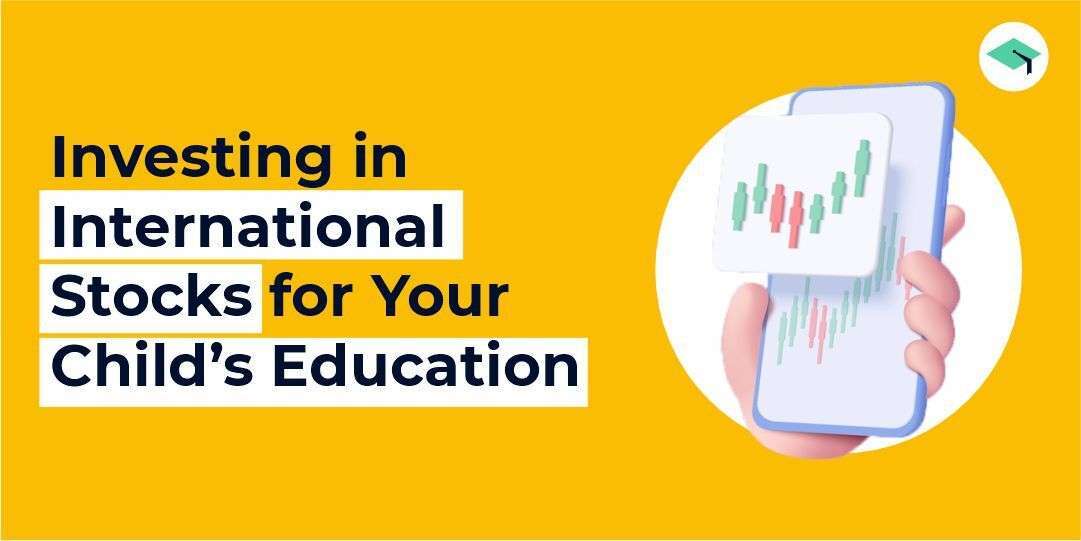With the rupee free-falling against the US dollar and increasing the cost of living for millions of Indian students studying in the USA or Canada, there can be no better time to start investing in international stocks for your child’s education.
Since immemorial, Indians have saved for education through investments in fixed deposits, gold, life insurance, and real estate. In an inflation-ridden economy, these investments may not be enough, especially if you plan to send your child abroad for higher education.
The growing cost of goods and services coupled with the depreciating value of the rupee against the dollar not only makes saving tougher but also affects your child’s future purchasing power.
Consider the table below – if even tuition and living expenses are kept constant over 17 years – the rupee will lose its dollar purchasing power. This can easily make foreign education more expensive for the average Indian parent.
| Currency | Jan-04 | Jun-21 | |
| Tuition | Dollar | 50,000 | 50,000 |
| Living | Dollar | 25,000 | 25,000 |
| Total | Rupee | 75,000 | 75,000 |
| 1=USD | Rupee | 45.45 | 73.32 |
| Total Cost | Rupee | 34,08,750 | 54,99,000 |
| Increase- 16% |
On top of this, tuition fees are rapidly rising. Some universities in the USA like Northwestern University and the University of Pennsylvania have increased their fees by 3.5% and 2.9% respectively.
Arizona State University hiked its tuition fees by 5% in 2021! This growing cost shows that Indians investing only in rupee assets to save for their child’s foreign education are likely to lose money over time.
To make sure your savings don’t lose value over time, investing in international stocks is the answer. This is a great way to diversify your investments.
Where to invest in the international stocks and the US market?
There are two types of US equity investments for Indian parents.
The first is stock listed on the Nasdaq and NYSE. One of the most popular and best-performing sets of stocks is FAANG, which represents Facebook, Apple, Amazon, Netflix, and Google. To invest in these stocks, you can buy certain shares of these companies individually or via mutual funds.
The second type is called Exchange Traded Fund (ETF). ETFs are traded on exchanges like Nasdaq and are several stocks put together. These stocks track indices such as the S&P 500 or one sector such as the tech or automotive industry.
Factors to consider before investing in the US market for your child
Note: Before investing in international stocks and the US market. Consider the risk, time horizon, and historical performance of the stocks or ETFs. Saving for education is a sensitive and tough goal so consider all factors carefully. The time on your hands can help you determine your risk level.
If you are a parent with a two-year-old then you can take more risks. You can consider riskier investments like a small-cap ETF such as the Invesco S&P SmallCap Value with Momentum ETF whose cumulative performance of over 100% over the past five years in dollars.
Whereas, as a parent of a 20-year-old aiming to study master’s in Canada within two years, your risk appetite is less. You can consider fewer volatility investments and consult with a financial advisor to create a comprehensive plan.
How to invest in US markets?
Indians can start investing by opening a USA brokerage account from their couch! There are many banks and financial partners that help you open an account to invest in international stocks.
Once the know-your-customer (KYC) process and verification are completed, you can fund your account and start saving.
Under LRS, Indians can remit up to $250,000 a year for any foreign capital or current account transaction. This includes investments in international stock markets. Market investments are a form of income generation, you are required to pay taxes.
Navigating investments in the US market can be daunting but worth the hassle. Considering the increasing cost of education, geographical diversification is key.
By accepting that foreign education and domestic education are only going to rise up, you can make room for considering powerful financial tools to fund your child’s dreams!
FAQs
Where should I invest in child education?
Ans. Investing in a diversified education fund or a 529 college savings plan can be a good option for child’s education.
These investment vehicles offer potential growth over the long term and may provide tax advantages. It’s important to research and consult a financial advisor to make an informed decision based on your specific circumstances.
Is it good to have international stocks in your portfolio?
Ans. Yes, having international stocks in your portfolio can add diversification and potentially reduce risk. It allows exposure to different economies and markets, enhancing overall investment opportunities.
Is it good for kids to invest in stocks?
Ans. Investing in stocks for kids can be educational and promote financial literacy. However, it carries risks, so parental guidance and moderation are essential.
Consider using custodial accounts or educational resources to ensure a responsible approach to investing.
